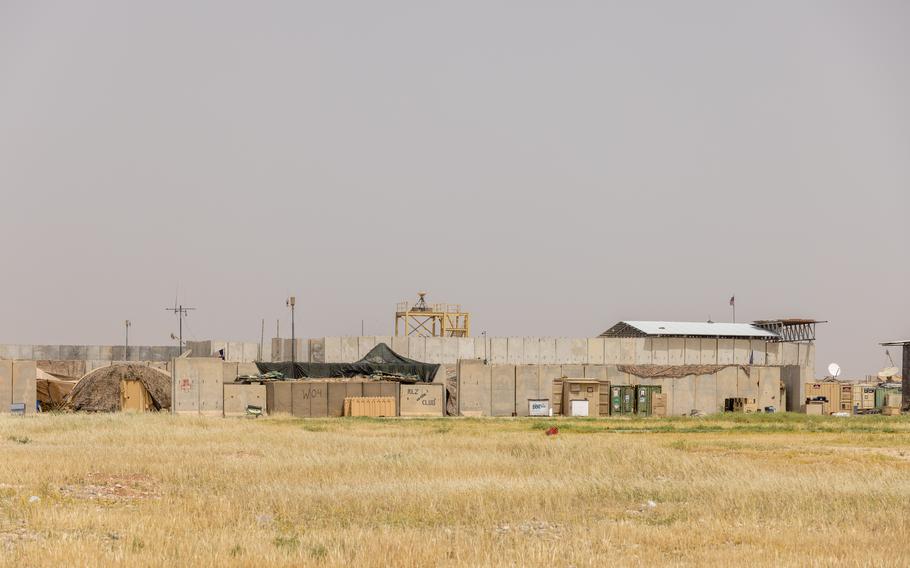
A U.S. Army camp at Rumalyn Landing Zone, Syria, on May 1, 2025. (Andrew Lightsey IV/U.S. Army)
President Donald Trump recently consolidated U.S. military bases in Syria, reduced troop levels and lifted all sanctions on the country, signaling U.S. support for the new government that took over after Bashar Assad was deposed. These are good moves given America’s emerging counterterrorism partnership with Syria.
Now Trump needs to take the next step and agree to withdraw the remaining 1,500 or so U.S. troops still in Syria. This will encourage regional cooperation and allow the U.S. to pivot to more pressing global challenges.
Strategically, a withdrawal makes sense, because conditions are especially ripe in Syria for the United States to pivot to a strategy of over-the-horizon counterterrorism (OTH-CT).
OTH-CT works best when threats decline due to a terrorist organization transitioning from global to local reach, meaning away from attacks against the U.S. and its closest allies in Europe and toward targets either in-country or in the surrounding region. This switch typically happens due either to a change in a group’s mission (as with Syria’s al-Nusra Front in the 2010s) or a weakened capacity to carry out global strikes. Every U.S. president since 9/11 has used this standard of global versus local reach as a barometer for when to wind down ground operations against terror groups.
Today, ISIS in Syria is a local-reach terrorist organization. Its caliphate collapsed in 2019, leaving it with no territorial control in Syria — a reality that won’t change anytime soon, even with recent increased attacks by the group inside Syria. As a recent report from the Center for Strategic and International Studies notes, direct ISIS attacks on Europe and the U.S. have ended since the collapse of the caliphate with the last coming in 2017 against Sweden.
Indicative of its weakness, ISIS-Syria has never directly attacked the United States. Since the rise of ISIS in 2014, the lone-wolf attacks in the U.S. inspired by ISIS propaganda were all homegrown, not planned or directed by ISIS-Syria. In fact, the group had no advance knowledge the attacks were coming.
These kinds of inspired attacks pretty much ended when the caliphate died. Outside of an attack in New Orleans in January, all other inspired attacks in the U.S., like in San Bernadino, Calif., or at the Pulse nightclub in Orlando, Fla., came prior to 2019. In short, there is no global-reach threat from ISIS-Syria today. “Jihadist terrorism in the United States is not resurgent,” a leading terrorism expert noted after the New Orleans attack.
The most active ISIS offshoot today — ISIS-K, which killed U.S. soldiers at the Kabul, Afghanistan, airport in 2021 — is not under the direct control of ISIS-Syria. The two groups maintain contact, but command and control lies exclusively with ISIS-K leadership. This, along with the fact that ISIS-K is based not in Syria but Afghanistan, highlights all the more the low level of threat to the U.S. from ISIS in Syria today. This again raises questions about why U.S. troops are still there, especially given the large number of times they’ve been attacked over the last year or so.
The second condition that makes OTH-CT optimal in Syria is the presence of capable actors inside and around the country with interests in monitoring and controlling ISIS.
To be most effective, OTH-CT requires, at a minimum, eyes on the ground to gather intelligence for potential quick U.S. strikes from outside the country if a global-reach threat emerges. With Syria today, the U.S. has that kind of in-country network — and then some. There is a large number of anti-ISIS actors both inside Syria — the new government in Damascus, the Syrian Democratic Forces, the Syrian National Army, and the Free Syrian Army — and across the region, specifically, Turkey, Israel, Jordan and Iraq.
All these players not only offer eyes and ears for U.S. intelligence gathering, but also provide to varying degrees boots on the ground to combat ISIS. Especially important is the SDF, which has been the key frontline U.S. partner in the battle against ISIS since 2014 and today guards a set of ISIS prison camps in northeast Syria.
Even better for the U.S., this disparate set of anti-ISIS actors has started working more closely together since the fall of the Assad regime in December, highlighted by a U.S.-brokered agreement whereby the SDF is integrating its civilian and military apparatus into the central state. This agreement, coupled with the Kurdish PKK laying down arms against the government in Turkey, will yield benefits in controlling ISIS. Turkish incursions into Syria and Turkish-backed SNA attacks against the SDF appear to be ending, which will allow the SDF to focus more on working with Damascus to control ISIS.
Counterintuitively perhaps, this anti-ISIS coalition could be further strengthened by a U.S. troop withdrawal from Syria. A big factor driving cooperation between Damascus and the SDF was concern Trump would withdraw troops when he came back to the White House. Both saw the need to work together, indicating that removing U.S. troops altogether will force local actors (like Israel recently) to work together all the more to take up the mantle of fighting ISIS.
All wars must end. It’s time to shift to over-the-horizon counterterrorism and get U.S. troops out of Syria — the sooner the better.
Will Walldorf is a professor of Politics and International Affairs at Wake Forest University and a Senior Fellow at Defense Priorities. He is currently writing a book titled “America’s Forever Wars: Why So Long, Why End Now, What Comes Next.”